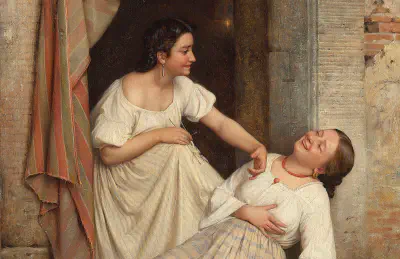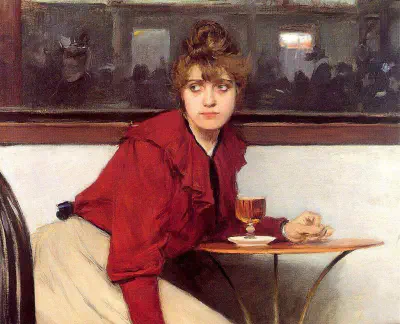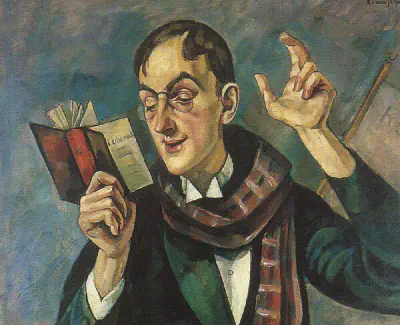In the last article in this series, we started exploring the opposite of work. If we want to understand the role that work has in human life, it is useful to think about all the things that we don’t consider to be work.
Often we understand what things are in terms of what they are not. And this is certainly the case with work. So, we define work in opposition to other things that we see as non-work—for example idleness, or play. This means that, if we want to understand the role of work in our thinking and our lives, we need to explore the boundary between work and non-work, and we need to think through the varieties of non-work.
Last week, we looked at one kind of non-work, and that is idleness. This week, we’re going to look at play—something that is related to idleness, but that is not quite the same.
Homo Ludens, or how we are made for play
Much of our lives is involved with playing. We joke with our friends. We play games and sports. When nobody else is around, we try to balance tennis balls on our noses just for the sheer thrill of it, or at a quiet bus stop, we wonder how long we can stand on one leg.
But when it comes to more philosophical accounts of human life, play is often overlooked. A good example of this is Hannah Arendt’s The Human Condition, which we explored in the second piece in this series. Arendt divides human activity into three broad categories: labour, or meeting our basic needs; work, or producing new stuff; and action, which covers the ways in which we engage in the transformation of our shared world.
Arendt’s is a persuasive account. But what is striking is that, throughout her detailed and careful account of human activity, Arendt gives very little attention to play. But any account of human activity that doesn’t take play into account is going to end up giving us a curiously skewed vision of human existence.
When you start to look for play, it is everywhere. As I write this, I look down into the square where I live in Sofia, Bulgaria. Two musicians are playing music. A teenager weaves through the crowd on a scooter, enjoying the arcs and the curves of their trajectory. Sitting on a bench, a woman plays on her phone. Outside the library, a child turns a sudden cartwheel…
The universality of human play is one of the reasons that the historian Johan Huizinga, in one of the 20th century’s most famous books about play, argued that we were not only Homo sapiens, human primates who are wise, or even Homo faber, human primates who make things. We are also Homo ludens, human primates who play. Huizinga writes,
There is a third function, however, applicable to both human and animal life, and just as important as reasoning and making namely, playing. It seems to me that next to Homo Faber, and perhaps on the same level as Homo Sapiens, Homo Ludens, Man the Player, deserves a place in our nomenclature. [1]
Play is different from idleness, even if the two often overlap. One reason it is different is because it is purposive, even if the purpose may have no value beyond itself. The person who plays, unlike the idle person, is at least doing something and doing something that seems to have some point. This is why, as philosopher Brian O’Connor points out, play doesn’t have quite the same air of disreputability as idleness. [2] But play is also different from idleness because it usually involves some kind of skill. Whether we are playing chess, or juggling, or playing the harp, or playing ball games, we are testing ourselves against our opponent or against the world, we are trying to find out what is possible for us: Can we really stand on one leg for the twenty minutes until the bus comes? Can we really beat this person at chess? Will the ball balance on our nose? And so on.
Fun in the animal kingdom
Play is not just a human phenomenon. Huizinga recognised this when he said that play is “applicable to both human and animal life.” Cats and dogs play. Lemurs play. Crows play. Otters love messing around. Far from being only a cultural phenomenon, play precedes human culture altogether. Huizinga puts it like this:
Play is older than culture, for culture, however inadequately defined, always presupposes human society, and animals have not waited for man to teach them their playing. We can safely assert, even, that human civilization has added no essential feature to the general idea of play. Animals play just like men. We have only to watch young dogs to see that all the essentials of human play are present in their merry gambols. [3]
And like human play, animal play is fun. In his book on animal pleasure, Pleasurable Kingdom, Jonathan Balcombe writes,
Though play is undeniably adaptive, it is pleasure, curiosity, and joy that provide the motivation for play in animals and humans alike. Play is a good indicator of well-being. It occurs when other needs, such as food, shelter and safety, are sufficiently met, and when unpleasant feelings like fear, anxiety and pain are minimal or absent. Otherwise the animal’s efforts would be directed at meeting these needs or relieving these feelings, at the expense of play. [4]
Play happens when we are freed up, if even for just a moment, from the demands of labour, and from having to attend to immediate questions of survival. Whether we are human beings or any other kind of animal, play takes place when our minimum needs are met. It takes place when we no longer have to worry about what Hannah Arendt calls labour.
Balcombe goes on to argue that animal play (and, therefore, human play too) exists for good evolutionary reasons. But these reasons are not what motivates animals, including ourselves, to play. As individuals, we are motivated to play not because it is adaptive, but because play feels good.
Play serves many functions that may help an animal to survive and succeed in life. These include: developing physical strength, gaining skills, acquiring knowledge, learning the ropes of social behavior, and exploring. This is probably why it evolved. But when a pair of mountain goat kids chase each other, jumping, twisting and kicking, they are hardly training for becoming good grown-ups. Animals play for fun, not for keeps. [5]
When Margaret the cat hides behind the armchair and then ambushes me as I pass by—grabbing hold of my legs with her claws retracted, then hurtling away across the room before circling back for a bit of fuss—she is not doing this out of a high-minded desire to keep in training (although I wouldn’t bet on the chances of any mouse who came her way). She is doing it because it’s a bit of a laugh, because she likes to surprise me like this.
And it is the same for us. We are into play not because of what it can do for us, but for its own sake: because playing is fun and gratifying. We play (you, me, and Margaret too) because we like playing.
Play, chance, and rules
But what does it mean to play? Play is something that happens at the meeting point of predictability and unpredictability. It involves both regularity and also surprise. In his book Truth and Method, the philosopher Hans-Georg Gadamer writes that,
In order for there to be a game, there always has to be, not necessarily literally another player, but something else with which the player plays and which automatically responds to his move with a countermove. Thus the cat at play chooses the ball of wool because it responds to play, and ball games will be with us forever because the ball is freely mobile in every direction, appearing to do surprising things of its own accord. [6]
But play also involves predictability and rules. If you offer me a game of Scrabble, and then you make up the rules as you go along, I’m unlikely to want to continue playing with you. The fun is testing our skills against each other as we together navigate a passage between the random chance of what letters we receive and the invariable rules of the game.
This is why Gadamer argues that play is also a serious business. He writes that “seriousness in playing is necessary to make the play wholly play,” Gadamer writes. “Someone who doesn’t take the game seriously is a spoilsport” [7] This is true also for games where the rules are more tacit than explicit. To continue playing along you need to be attuned to these tacit rules. Without this awareness, it is easy to derail the game and derail the fun.
One of the tacit rules of the ambush game I play with Margaret the cat is that I good-naturedly let her attack me, and after she has done this, she comes back so that I can give her a bit of fuss. But if when she ambushed me, I freaked out, yelling at her and storming out of the room, I would clearly have broken our tacit agreement about how things should go. The game would be ruined. And Margaret could justifiably brand me a spoilsport.
It’s not about winning, unless it is about winning
So why do we play? For some kinds of play, the fact that there are winners and losers is an integral part of the game. But this isn’t true in all kinds of play. A helpful distinction is made by James Carse, the scholar of religion, between finite and infinite games. In his book, Finite and Infinite Games, Carse writes,
There are at least two kinds of games. One could be called finite, the other infinite. A finite game is played for the purpose of winning, an infinite game for the purpose of continuing the play. [8]
When I was at school, being generally inept on the sports field, people sometimes told me that winning and losing were not the most important things. What was important, these kind souls told me, was taking part. But this is not quite true. For many finite games, winning and losing are a part of the fun. And this means that playing against somebody who always loses (I really was that inept…) is really no fun at all. Winning may not be the only pleasure, but if you are playing football or Scrabble or any other finite game that entails the possibility of winners and losers, then for many players, if your opponent is hopeless, or if your opponent doesn’t care about winning, this spoils the point of the game. Part of the fun is that you care and that your opponent cares.
But with infinite games—like the infinite fun to be had playing mouse-on-a-string, one of Margaret’s favourite games (with a toy mouse attached to a long string)—the fun of the game is not bound up with winning and losing, or with the outcome. The point of play is to sustain itself, to keep this attitude of playfulness going (until we get hungry, or tired, or bored, or distracted, and go and do something else).
Play and playfulness
In her brilliant book Metaphor and Metaphilosophy: Philosophy as Combat, Play, and Aesthetic Experience, philosopher Sarah Mattice explores both the philosophy of play, and also the idea that philosophy itself could be seen as a kind of play. Mattice draws on the work of María Lugones to argue that the attitude of playfulness is “an approach to others that respects them while attempting to enter into relations of understanding.” [9]
These others might be our fellow human beings. But many things can count as others in this sense: other people, animals, or even things. When playing mouse-on-a-string with Margaret, I’m interacting with her in a way that attempts to understand her more. And this attempt at understanding is where a lot of the fun lies (I am also, of course, attempting to understand better the physics of toy mice attached to strings). And when I realise that I “get” Margaret, that I understand her behaviours a little more deeply, or when I intuit that through our game Margaret “gets” me, the game is immensely gratifying.
This may sound sentimental. But if we are human animals, and if play is something that we do by virtue of being animals, then this is more than sentiment. It is a recognition that Margaret and I, as animals who are trying to navigate the world we share, are interested in testing out each other and our shared world. We are interested in finding out about each other, and about the world we inhabit together. As the Renaissance French philosopher, Michel de Montaigne asked, “When I play with my cat, how do I know that she is not passing time with me rather than I with her?” [10]
Seen like this, playfulness is a way of connecting more deeply with the many things—cats, dogs, juggling balls, human beings, footballs, dice, Scrabble tiles, toy mice tied to strings—with which we share the world. And for this reason, playfulness could be seen as an attitude that is more fundamental than play itself. Mattice argues that,
To be playful with things, events, and others in the world is to bring to every situation an attitude that has the potential to turn that situation into play. [11]
Philosophy as an infinite game
Mattice pushes her argument further to suggest that philosophy itself could be seen as a kind of infinite game. Sometimes we think of philosophy as a kind of combat—as a kind of finite game. We debate with each other, we compete for who has the best arguments in the marketplace of ideas, and ultimately, there are winners and losers.
But do we have to see philosophy like this? Is engaging in antagonistic debate really the best way to try to orientate our lives towards greater wisdom? Or does the metaphor of play (or is it more than a metaphor?) offer us another way of thinking of philosophy? Mattice writes,
Understanding philosophical activity as play means seeing it as an activity that has no beginning and no end, but that is ceaselessly transforming and changing. Philosophical thinking as play… does not fix itself in any one position, but treats each position as a temporary lodging-place, moving flexibly at the axis of the wheel. The philosopher, in playing, has no set purpose or goal in mind, other than enjoyment of the activity itself. [12]
This is not, as Mattice herself knows, the last word on what philosophy is or what it could be. But it is a valuable counter-balance to the idea that philosophy is—inherently and by its very nature—about confrontation, and about a contest of ideas in which there are winners and losers.
Questions
- What do you think main differences are between infinite and finite games? Which do you prefer?
- Is play always the opposite of work? Or is it possible to work playfully? How does this change our experience of work?
- Is seriousness involved in all kinds of play, or only some of them?
- Can the idea of play be integrated into Arendt’s account of the active life? If so, how?
- What are the implications of thinking about philosophy as a kind of play? How might this transform our approach to philosophising?
Notes
- Johan Huizinga, Homo Ludens: A Study of the Play-Element in Culture (Routledge 1980), foreword.
- Brian O’Connor, Idleness (Princeton University Press 2018), e-book.
- Homo Ludens, p. 1
- Jonathan Balcombe, Pleasurable Kingdom (Macmillan 2006), p. 68
- ibid., p. 69
- Hans-Georg Gadamer translated Joel Weinsheimer and Donald G. Marshall, Truth and Method (Continuum 1989), p. 106
- Truth and Method, p. 103
- James Carser, Finite and Infinite Games: A vision of life as play and possibility (The Free Press 1986), p. 3
- Sarah Mattice, Metaphor and Metaphilosophy: Philosophy as Combat, Play, and Aesthetic Experience (Lexington Books 2014), p. 70
- Michel de Montaigne translated M.A. Screech, Essays (Penguin Books 2003) e-Book
- Metaphor and Metaphilosophy., p. 70
- ibid. p. 70
More further reading
Books and articles
Try Ian Bogost’s Play Anything: The Pleasure of Limits, the Uses of Boredom, and the Secret of Games, which takes a fascinating look at play and constraint (Basic Books 2016)
A good place to start exploring the rich scholarship on play is the American Journal of Play, which can be found online here.
Image: Pieter Brueghel the Elder: Children’s Games. 1560. Public domain via Wikimedia Commons.



